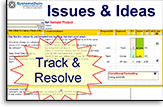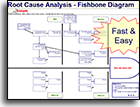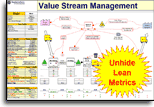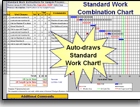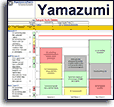Installation and Setup
Installation - Each User. Installation - Multi-user. Language Translations. Personalize Your Templates.Systems2win Training.
Quick Start Initial Training. New User Training. Training Matrix. Systems2win Leadership. Training Classes.Lean Training
Lean Training and Coaching. Lean Principles. Muda 8 Wastes. Goal - Lean Flow. Roadmap - Lean Journey. Value Stream Mapping. Standard Work. Hansei Lean Thinking. Lean Dictionary. Online Lean Training. Lean Leadership.Microsoft Office Training
Excel Training. Excel Drawings (without Visio). Excel Charts. Word Training. PDF Training. Document Storage and Naming.Support
Support.Hansei
Lean Thinking
"Thinking is the hardest work there is. That's why so few people do it." Henry Ford
By far the most important step of any problem solving method is
to pause to analyze, ponder, and reflect
on what has been discovered, what has been learned, what is still unknown...
to conceive possible countermeasures
that go beyond "obvious" initial thoughts
to daydream about alternate futures
that are more desirable, more compelling, more...
Hansei
Hansei is the Japanese word for this form of self-reflection, and it should be the single most important activity to happen in every PDCA cycle.
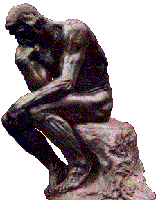
Ponder, Think, Reflect
When to use
Hansei Lean Thinking
Every time that you reach the 'Study' or 'Check' phase of the PDSA or PDCA cycle,
it's time for each of your team members to (independently) think, ponder, and reflect:
- What did you expect to happen?
- What actually happened?
- What did you learn?
- What still needs to be learned?
- What experiment should we do next?
- How should that experiment be designed?
- When ready, what's the best way to standardize?
to secure, ratchet, and expand our hard-won learnings
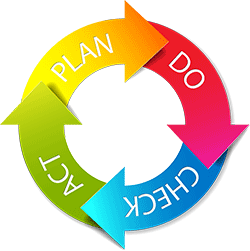
PDCA Cycle
(or any other problem solving method)
Deep Thinking is best done alone
Deep thinking is best done alone in a silent, focused state of deep reverie.
Knowing this, most experienced teams allow a day or two after identifying problems and root causes before moving into proposed countermeasures.
How to use this hansei page
This page is not meant to be read like a book.
It is overflowing with questions and idea-starters...
each one worthy of focused attention at different times, to solve different problems
The most successful way to use this page
is to bookmark it, and come back to it each time that you have completed another cycle of Process Analysis and you are ready to (again) begin thinking about Process Improvement
(in a never-ending cycle of continuous improvement)
In a quiet, comfortable setting...
(perhaps with a warm beverage)
Review what you have learned so far by using your chosen Problem Solving Method.
What is known? What is unknown?
Set your intention
What is your intention for this Hansei session?
(Perhaps to come up with creative countermeasures for a specific challenge)
Enter an empowered state of mind
Enjoy some short ritual that brings you to an empowered state of calm alertness
Perhaps do a quick refresher
of our online training for
How to use trance for process improvement

Wander, then focus
With partially focused eyes, allow your attention to wander as your eyes dance over the somewhat blurry words on this Hansei page...
until your attention effortlessly settles on one question or idea that draws you to it
Ponder
Ponder that question or idea...
scribbling short notes, but not getting too detailed yet
Repeat
Then repeat that same habit... again and again...
until you surprise yourself with how many creative and useful ideas you have come up with.
Choose
Later... come back to your scribbled notes, and choose which ones you want to flesh out in greater detail
Perhaps using your decision making tools and/or perhaps using your Change Management template (ChangeMgmt.xlsx) to think about how to best present your ideas to the various stakeholders that might be affected by the changes.
Create Change
Complete the final phases of your chosen Problem Solving Method to:
- Physically implement change
- Validate whether or not those changes produced your expected results
- Either Start Over - with fresh ideas,
or Standardize and Socialize your success
Perhaps use your Tool Selection Matrix (1ToolSelection.xlsx) to choose useful Process Improvement Tools and Systems to implement your ideas.
And then don't keep this a secret
People that consistently come up with well-conceived and well-presented great ideas will inevitably be promoted to higher levels of responsibility and influence.
One of the most important roles of any leader is to groom others
to improve their own habits
and systems for creative thinking and problem solving...
ideally using teachable, repeatable systems for continuous improvement
like this one
Reflection Idea-Starter Questions
to stimulate Hansei and Lean Thinking
- What does this customer really want and need?
How we (truly) listened to the Voice of our Customer?
How well does this process fulfill those true needs? -
Have we analyzed this process in the context of its value stream?
(to consider flow between processes)
- Have we performed process analysis?
(to consider flow within the process)
- What do we see?
What types of waste do we see?

- Which of the 4 Rules in Use are broken?
In what ways?
- Which Lean Principles are broken?
In what ways?
- Where is flow being obstructed?
Where is inventory piling? Information flow stopping, clogging, and queuing?
Why? How might things be redesigned to flow unobstructed?
- Where are things being batched?
Why? How might things flow in smaller clumps?
- Where are things being pushed downstream before the next process is ready for it?
How might they be pulled?
- Where is there confusion, and lack of a standardized way of doing things?
What might help? Which standard work tools and methods might help?
- What policies might be affecting this process?
(e.g. quarterly quotas, seasonal promotions, etc.)
Who has the power to reconsider these policies?
- Have we considered this from the perspective of the concerns of all stakeholders?
Have we played catchball? to ask others for their thoughts, their questions, their concerns, their ideas...

- Have all of the Gemba Interview questions been asked? (GembaInterview.xlsx)
Have we asked all of the right people?
What do we see in those answers? - What is NOT the problem?
Use your Is Is Not Analysis template
- Why? Why? Why? Why? Why?
What is the root cause of this problem?
- How do we know?
(that our data is accurate, that our assumptions are correct, that we're making progress...)
- Have we done sufficient brainstorming of creative ideas?
Are we trying to narrow our focus, or expand our thinking?
- Where are we in our process improvement cycle?
Which step? What's next?
- What have we learned?
What did we expect to happen? What actually happened?
- What's next?
Are we ready to standardize this process to lock in the new (better) way?
Or should we run another PDCA experiment to learn something that still isn't fully understood? - How can we best standardize work to ensure that everyone does it the new (better) way?
How might we make work and flow more visual?
What other processes or teams might benefit from similar changes?

Who needs standard work?
Lean Thinking = Systemic Thinking
Systemic Thinking consists of both:
1) Analytical thinking
(very common)
Thinking about parts or elements.
Taking apart.
Isolating root causes.
2) Synthetical thinking
(much less common)
Thinking about how parts and elements interact as part of a greater whole.
Looking for repeating patterns and themes.
Identifying similar processes that could also benefit from your most recent learning lessons.

To find tools to expand your thinking,
filter the 'Expand' column
in your Tool Selection Matrix
Lean Process Design Objectives
Objectives to keep in mind when getting into the details of lean process engineering
The most important lean objectives
- Lean Principles and Ideals
- Lean Flow
- Lean 4 Rules In Use
- Avoid the Deadly Wastes of Muda
- Use the PDCA scientific method
Between Do and Act...
set aside some uninterrupted quiet time
to think, ponder, and reflect on what you've learned (Hansei)

Technical Design objectives
- Ask "How would this process be if it were waste free?"
- Ask the A3 Gemba Interview questions to unearth all types of muda. Any here?
- Examine the value added by each activity (as perceived by the customer)
- Eliminate unnecessary non-value-add activities
- Reduce non-value-add activities that are 'necessary' for the way we do things now
- Simplify processes
- Consider opportunities for self-service
- Consider opportunities to transfer responsibility to suppliers or outsource service providers
- Consider possibilities for someone with lesser skills to reliably accomplish this work
- Consider opportunities to eliminate the need for sub-processes
- Consider opportunities to combine multiple activities into one
- Consider opportunities to split a single complex process into simpler processes
- Make user interfaces easier and more productive
- Eliminate 'islands of information' — make information available to everyone that needs it
- Eliminate redundant data entry
- Eliminate redundant verifications and controls (that are only needed if the process is untrustworthy)
- Eliminate handoffs (and all their associated errors, inefficiencies, and time delays)
- Relocate, retime, and redesign controls to provide information in its most useful form, time, and place
- Is there a clearly-marked place for everything?
(inventory, tools, people, equipment, instructions, performance feedback mechanisms...)
- Is it safe?
- Is it ergonomic?
- Can routine maintenance be performed easily?
Idea poppers

- Try reversing it. Try it forwards & backwards. Try pushing & pulling.
- Focus on what is constant and similar
- Focus on what is variable and different
- Enlarge or reduce. (A larger handle. Larger dial. Magnifying glass...)
- Concentrate or disperse
- Link or separate
- Add or delete
- Think parallel. Think sequential.
- Change the sequence
- How might sorting take advantage of differences and common features?
- How might colors, shapes, or icons be used for more obvious visual management?
Modularization
- How can this process be divided into more bite-sized modules?
- Which pieces of the re-designed process could be implemented independently?
- When should we deploy each modular portion?
- How might we start by testing a limited-scale prototype?
"The quality of your life is determined by the quality of your questions."
~ Tony Robbins
Hansei Social Design Objectives
Empower Customer Contact Personnel
- Teach everyone in your company to use Problem Solving Tools and Methods
- Provide customer contact personnel the responsibility, authority, knowledge, skills, and tools to provide what customers want from them — quickly and efficiently.
- The ideal is for one person to be able to handle everything the customer needs. If it proves too much for one person, then make it the responsibility of one clearly-defined team.
- After starting with the people and teams that have direct interface with external customers, extend this same concept to the people and teams that serve internal customers.
Design simple processes and fulfilling jobs
In general, process redesign should:
- Replace complex processes segmented into simple jobs
- Create simple processes performed by workers with more complex (and fulfilling) jobs
Reduce organizational boundaries
Re-draw organizational boundaries to:
- Reduce the number of organizations traversed by a single process
- Ensure that all members of a team reside within a single organization

Every lean tool needs
a corresponding
Lean Coaching System
Recast management as a supporting role
When front-line people are empowered, they need:
- Clear goals, clear measurements, and clear rewards
- Personal development coaching
- Resources and elimination of obstacles
They don't need:
- Daily micro management
- Layers of managers above them obstructing communication in both directions
Ensure job security

Reassure people that it is safe to contribute their ideas for process improvement, using your templates for:
- Job Security Promise
- Change Management Stakeholder Analysis
- Job Design Matrix for career path planning
Hansei Idea Generation Tools
for continuous process improvement
Some of the more popular Idea Generation tools for lean process improvement include:

There are many more lean tools that can be used to expand your team's thinking.
To find them, filter the 'Expand' column in your Tool Selection Matrix
Own all of these templates for Continuous Process Improvement
to empower every team to improve every process in your organization
Contents
Training and Coaching
Consider Training and Coaching to support your teams to succeed

Training to get you started.
Tools you won't outgrow.
Schedule a Conference
Schedule a conference
to discuss your challenges
with an experienced lean advisor

No, we're not going to
buy you any tools...
but we don't want any excuses when those deadlines are due
Own Yours Now
Own your own professional tools
that you can take with you for the rest of your career
Download Trial Now
Get a dozen trial templates,
and another dozen free gifts
@@@ Better conversion rate
if call to action is for a specific tool, and shows the image

Try It
Try this template
along with a couple dozen more
process improvement tools
Calls to Action Botttom
Related Topics
Related Topics section WITHOUT TESTIMONIALS
Replace this paragraph with menu library item for topics related to this video
Training and Coaching
Consider Training and Coaching to support your teams to succeed

Training to get you started.
Tools you won't outgrow.
Schedule a Conference
Schedule a conference
to discuss your challenges
with an experienced lean advisor





